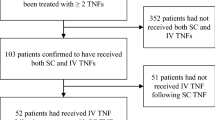Abstract
Background
Crohn’s disease (CD) is an intractable disease that requires long-term treatment. Tumor necrosis factor (TNF) inhibitors have strong efficacy and are widely used for CD treatment. However, a loss of response is one of the issues in long-term TNF therapy. To identify the factors affecting the efficacy of long-term CD treatment with TNF inhibitors, we conducted a retrospective study of treatment outcomes and clinical factors using clinical data over a 14-year period.
Methods
Clinical characteristics and factors for surgery, hospitalization, and TNF inhibitor treatment discontinuation were examined in 219 biologic-naïve patients who were treated with TNF inhibitors at our hospital before October 2014.
Results
Treatment persistence rates with no hospitalization, surgery, or dose escalation were 60.7, 25.9, and 17.3% for 1, 5, and 10 years, respectively; these rates did not differ between infliximab (IFX) and adalimumab. In patients receiving IFX dose escalation, 1- and 5-year persistence rates were approximately 90.4 and 65.1%, respectively. Previous surgery (OR = 1.45, P = 0.043) was identified as a risk factor for surgery, male sex (OR = 0.70, P = 0.044) and previous surgery (OR = 1.51, P = 0.03) were risk factors for hospitalization, and perianal fistula (OR = 1.39, P = 0.049) was the risk factor for TNF inhibitor treatment discontinuation.
Conclusions
The durability of anti-TNF therapy in CD patients remains a problem, and treatment optimization that includes dose escalation should be carefully examined depending on patient characteristics and the timing of optimization.



Similar content being viewed by others
References
Peyrin-Biroulet L, Cieza A, Sandborn WJ, et al. International Programme to Develop New Indexes for Crohn’s Disease [IPNIC] group. Development of the first disability index for inflammatory bowel disease based on the international classification of functioning, disability and health. Gut. 2012;61:241–247.
Ben-Horin S, Chowers Y. Review article: loss of response to anti-TNF treatments in Crohn’s disease. Aliment Pharmacol Ther. 2011;33:987–995.
Hazlewood GS, Rezaie A, Borman M, et al. Comparative effectiveness of immunosuppressants and biologics for inducing and maintaining remission in Crohn’s disease: a network meta-analysis. Gastroenterology. 2015;148:344–354.
Suzuki Y, Matsui T, Ito H, et al. Circulating interleukin 6 and albumin, and infliximab levels are good predictors of recovering efficacy after dose escalation infliximab therapy in patients with loss of response to treatment for Crohn’s disease: a prospective clinical trial. Inflamm Bowel Dis. 2015;21:2114–2122.
Hibi T, Sakuraba A, Watanabe M, et al. C-reactive protein is an indicator of serum infliximab level in predicting loss of response in patients with Crohn’s disease. J Gastroenterol. 2014;49:254–262.
Beaugerie L, Seksik P, Nion-Larmurier I, et al. Predictors of Crohn’s disease. Gastroenterology. 2006;130:650–656.
Veloso FT, Ferreira JT, Barros L, et al. Clinical outcome of Crohn’s disease: analysis according to the vienna classification and clinical activity. Inflamm Bowel Dis. 2001;7:306–313.
Solberg IC, Vatn MH, Hoie O, et al. Clinical course in Crohn’s disease: results of a Norwegian population-based ten-year follow-up study. Clin Gastroenterol Hepatol. 2007;5:1430–1438.
Greenstein AJ, Lachman P, Sachar DB, et al. Perforating and non-perforating indications for repeated operations in Crohn’s disease: evidence for two clinical forms. Gut. 1988;29:588–592.
Louis E, Michel V, Hugot JP, et al. Early development of stricturing or penetrating pattern in Crohn’s disease is influenced by disease location, number of flares, and smoking but not by NOD2/CARD15 genotype. Gut. 2003;52:552–557.
Romberg-Camps MJ, Dagnelie PC, Kester AD, et al. Influence of phenotype at diagnosis and of other potential prognostic factors on the course of inflammatory bowel disease. Am J Gastroenterol. 2009;104:371–383.
Chow DK, Sung JJ, Wu JC, et al. Upper gastrointestinal tract phenotype of Crohn’s disease is associated with early surgery and further hospitalization. Inflamm Bowel Dis. 2009;15:551–557.
Golovics PA, Mandel MD, Lovasz BD, et al. Is hospitalization predicting the disease course in Crohn’s disease? Prevalence and predictors of hospitalization and re-hospitalization in Crohn’s disease in a population based inception cohort between 2000–2012. Gastroenterology. 2014;146:S–438.
Colombel JF, Sandborn WJ, Reinisch W, et al. Infliximab, azathioprine, or combination therapy for Crohn’s disease. N Engl J Med. 2010;362:1383–1395.
Roblin X, Marotte H, Leclerc M, et al. Combination of C-reactive protein, infliximab trough levels, and stable but not transient antibodies to infliximab are associated with loss of response to infliximab in inflammatory bowel disease. J Crohns Colitis. 2015;9:525–531.
Dulai PS, Siegel CA, Peyrin-Biroulet L. Anti-tumor necrosis factor-α monotherapy versus combination therapy with an immunomodulator in IBD. Gastroenterol Clin North Am. 2014;43:441–456.
Dulai PS, Siegel CA, Colombel JF, et al. Systematic review: monotherapy with antitumour necrosis factor α agents versus combination therapy with an immunosuppressive for IBD. Gut. 2014;63:1843–1853.
Matsumoto T, Motoya S, Watanabe K, et al. Adalimumab monotherapy and a combination with azathioprine for Crohn’s disease: a prospective, randomized trial. J Crohn’s Colitis. 2016;10:1259–1266.
Acknowledgments
We would like to express special thanks to the medical clerk Ms. Emu Ikarigawa who was extremely helpful in gathering clinical information from the study patients. This study was supported in part by Health and Labour Sciences Research Grants for research on intractable diseases from the Ministry of Health, Labour, and Welfare of Japan.
Author information
Authors and Affiliations
Corresponding author
Ethics declarations
Conflict of interest
No conflict of interest related to this manuscript.
Rights and permissions
About this article
Cite this article
Osamura, A., Suzuki, Y. Fourteen-Year Anti-TNF Therapy in Crohn’s Disease Patients: Clinical Characteristics and Predictive Factors. Dig Dis Sci 63, 204–208 (2018). https://doi.org/10.1007/s10620-017-4846-x
Received:
Accepted:
Published:
Issue Date:
DOI: https://doi.org/10.1007/s10620-017-4846-x




